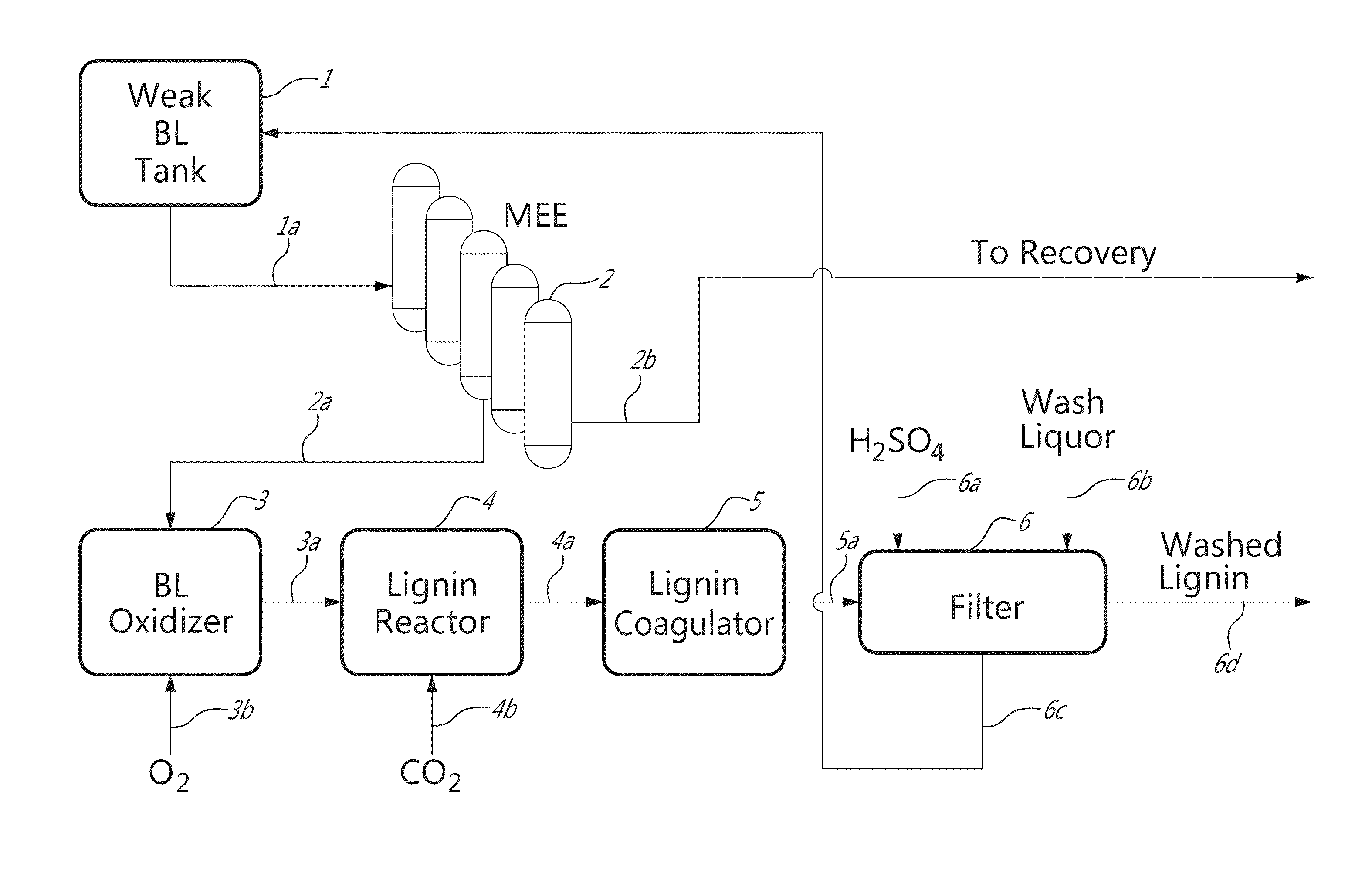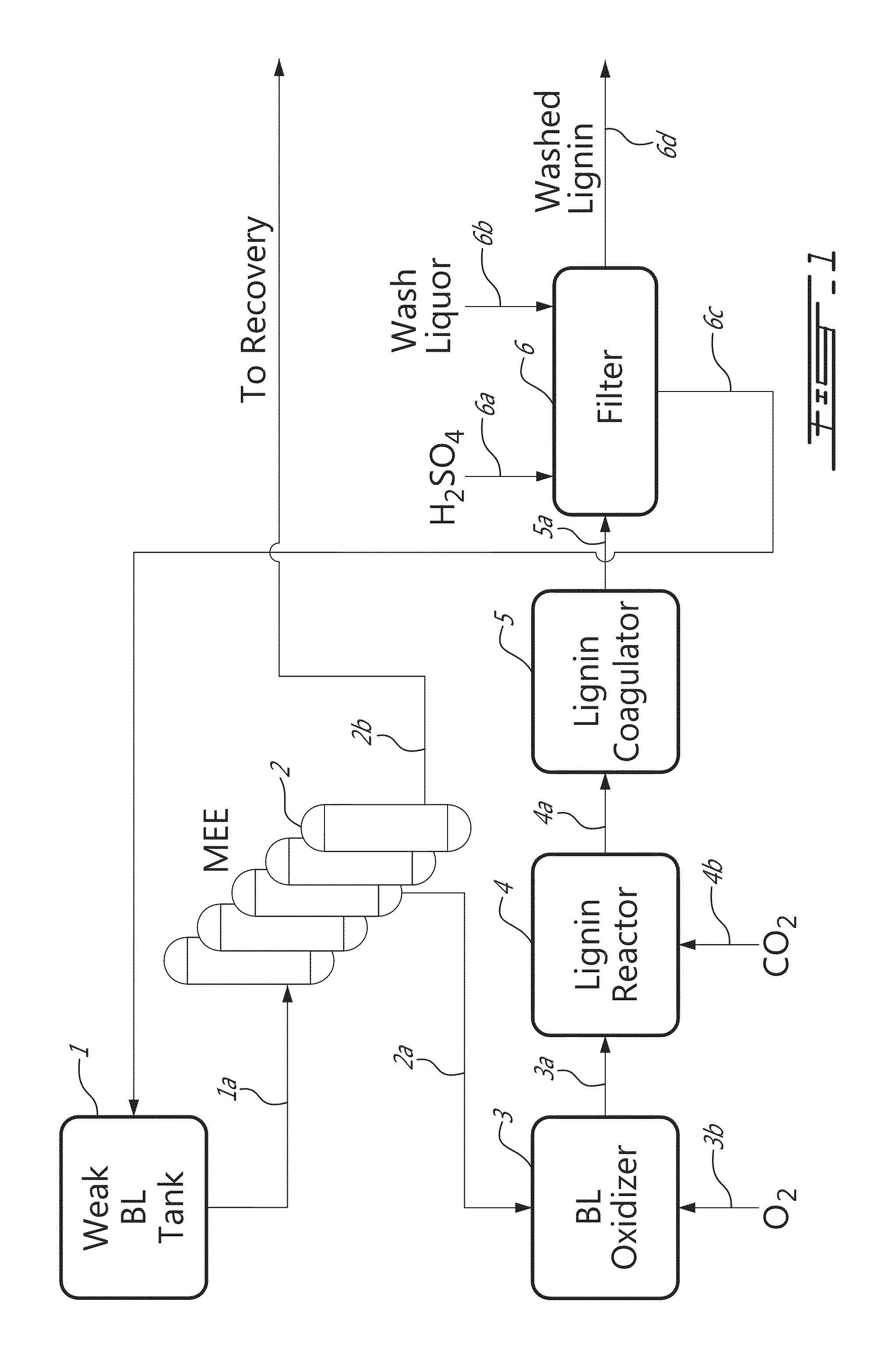[0019]It has been found, in accordance with the invention, that by partially oxidizing black liquor using
oxygen to the extent needed to destroy TRS components prior to lignin
precipitation with acid, the filtration rate of the acid-precipitated lignin
slurry improves significantly. This is a very surprising result considering that the opposite effect was suggested in the prior art (e.g. Tomlinson, G. H. and Tomlinson, G. H. Jr., Method of treating lignocellulosic material, U.S. Pat. No. 2,406,867 (1946); Ohman, F.,
Precipitation and separation of lignin from kraft black liquor, Ph.D. Thesis, Chalmers University of Technology, SE-412 96, Gothenburg, Sweden, p. 12). It appears from the data that black liquor oxidation provides suitable conditions for lignin
colloid agglomeration with respect to pH (leads to a lower pH), temperature (leads to a higher temperature) and the relative valence of the inorganic electrolytes in solution (e.g. oxidation converts
sodium hydrosulphide, a salt in which both the cation and anion are monovalent to
sodium thiosulphate and sodium sulphate in which the cation is monovalent but the anion is
divalent). In addition, black liquor oxidation prior to lignin precipitation leads to a final lignin product of a higher dry solids content compared to unoxidized black liquor.
[0020]Furthermore, it has been found that this black liquor pretreatment step led to reduced acid requirements for the acidification step during lignin precipitation from black liquor, reduced acid requirements during the washing step, and reduced TRS emissions during all steps associated with lignin precipitation, filtration and washing. These improvements in acid requirements can be explained by the fact that the oxidation of sulphide to sulphate and organics (e.g. sugars) to organic acids (e.g.
sugar acids) consumes the residual effective alkali (
sodium hydroxide) in black liquor.
[0022]A second option following the destruction of TRS compounds, would be to simply let the black liquor stand for a certain period of time at a high temperature. In particular, in the absence of
sodium sulphide and mercaptide, the
hemicellulose in the black liquor is then amenable to peeling reactions which generate saccharinic acids (Increased yields in alkaline pulping. I. A study of the peeling reaction at the conditions of kraft pulping, Project 2942, Report 1, Dec. 18, 1970.), thereby consuming
alkalinity and reducing the amount of
acidifier required for the acidification of the black liquor.
[0025]The acidification brings the pH of black liquor close to the pKa (acidity constant) of the phenolic groups in lignin which is about 10. At this pH, 50% of the phenolic groups in lignin are in the sodium form (completely dissociated form) and the other 50% in the acidic form (mostly undissociated form). In this state, some lignin molecules (e.g. high MW) come out of solution and form colloidal particles which following agglomeration and coagulation (simply time in a tank) grow to particles of a size around 5-10 micron
average diameter which are easy to filter.
[0027]It is also possible to stop the acid addition at a lower pH (e.g. pH 9) in which case the average molecular weight of the lignin recovered will be lower, the lignin
recovery yield will be higher but the
carbon dioxide consumption will be higher. The latter is higher because the
carbon dioxide not only neutralizes the residual
sodium hydroxide in black liquor but also begins to react with the residual
sodium carbonate to form
sodium bicarbonate.
[0029]1. To offload the
recovery boiler with respect to calorific load thereby enabling
recovery-boiler limited mills to produce more pulp (usually 1 more tonne of pulp per tonne of lignin taken out);
 Login to View More
Login to View More 


